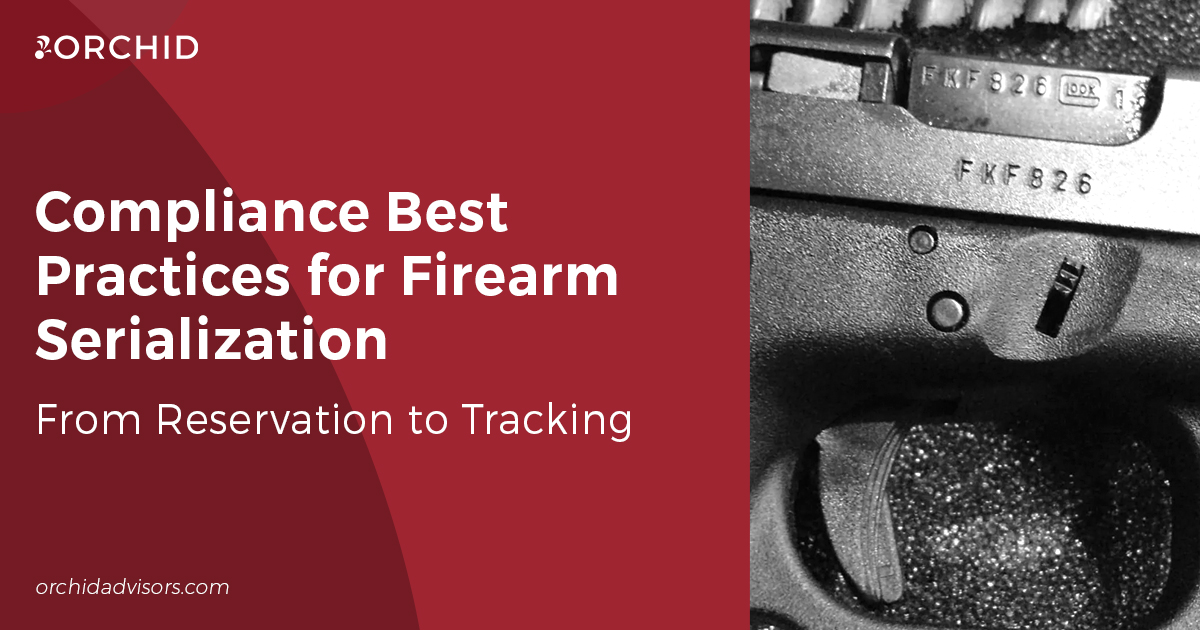As a licensed firearms manufacturer (FFL Type 07) or importer (FFL Type 08), federal regulations require every firearm manufactured or imported be legibly identified with an individual serial number and additional information. The primary reason for serialization is to aid law enforcement efforts in tracing firearm origination and movement in the commercial sector, as well as identifying suspicious transaction activity. Serial numbers also allow FFLs to maintain accurate and complete bound books and other regulated records.
While there are specific requirements for where the serial number and information are placed, there are many ways to serialize a firearm, including engraving, casting and stamping (impressing), which many of today’s modern firearm manufactures achieve with laser technology. However, there’s more to firearm serialization than simply marking firearms.
From reservation to tracking, we’ll review four compliance best practices to consider throughout the firearm serial number management process.
Establish Serialization Standards
Today, most FFL manufacturers use software to integrate their enterprise resource planning (ERP) system and marking hardware with a centralized database, allowing part numbers to be connected to serial numbers and their application automated. While less susceptible to human error, this process is not without potential compliance pitfalls.
Before a firearm can be serialized, standards must first be in place to determine where serial numbers are applied and how numbers will be reserved. ATF regulations require serial numbers be placed in a manner not susceptible of being readily obliterated, altered or removed, as well as no numbers be duplicated. By determining serial number placement, format, sequence and batch size prior to production, FFL manufacturers can ensure they maintain consistency and compliance throughout the serialization process. Standards should also include establishing who has access to the reservation database to make necessary updates and changes.
Follow Marking Requirements
Specified in 27 CFR § 478.92, the ATF lays out various marking requirements for firearm serialization. To maintain FFL compliance, firearm manufacturers and importers must ensure the following:
- Serial numbers must be placed conspicuously on the firearm frame or receiver.
- The engraving, casting or stamping (impressing) of serial numbers must be to a minimum depth of .003”, measured from the flat surface of the metal, and in a print size no smaller than 1/16”.
- Additional information, including (a) model, (b) caliber or gauge, (c) name of domestic or foreign manufacturer, (d) city and state of domestic manufacturer, and (e) foreign manufacturer country and city and state of importer, must be placed conspicuously on the frame, receiver or barrel.
All serialized firearms should be examined and validated to ensure compliance with these regulations prior to their distribution in commerce.
Track Inside Your Facility
The methods used by an FFL to track firearms inside their facility depends upon the size and complexity of the business. After all, tracking the whereabouts of a compact pistol inside the confines of a 1,000,000-square-foot building necessitates a more robust environment than that of one a one-hundredth of the size. However, no matter how large your business or facility is, tracking firearms throughout the serialization process is critical to limiting theft and loss.
Whether done manually or by way of a warehouse management system (WMS), firearms should be tracked as they transition from works in progress to finished goods. This includes noting where firearms are physically stored, at what stage of completion they are at and that the serial numbers and required information match you’re A&D bound book records. Tracking is also important when shipping firearms, as proper picking and labeling processes can prevent false dispositions and “wrong gun in box” scenarios when fulfilling orders.
Maintain Accurate & Timely Records
The importance of establishing standards prior to serialization is to maintain accuracy of firearms transactions in your FFL bound book. Not caught, a wrong serial number could lead to a wrong acquisition and disposition records, with errors passed down the supply chain and ultimately onto the consumer, resulting in major ATF violations.
Once a firearm has been serialized and the physical product validated for required information, that information must be checked for accuracy against an acquisition entry – whether automated or done manually. The serial number and information data must match the markings on the firearm and, by law, must be recorded within seven days for manufacturers or 15 days from the date of released from U.S. Customs for importers. Data and dates should also be confirmed when firearms are disposed of for shipping, theft/loss or destruction.
No matter what serial number structure you select, what method you use to mark firearms, how you track firearms in your facility or the frequency in which you perform “book to physical” inventories, your FFL can limit compliance risk throughout the serialization process by following these best practices.
Contact us today to learn how your firearms manufacturing or import business can integrate existing software and processes with Orchid eSerial™, eBound™ and ERP Accelerator™ solutions, as well as navigate ATF regulations, to ensure your FFL is running at maximum efficiency with the utmost compliance.








0 Comments